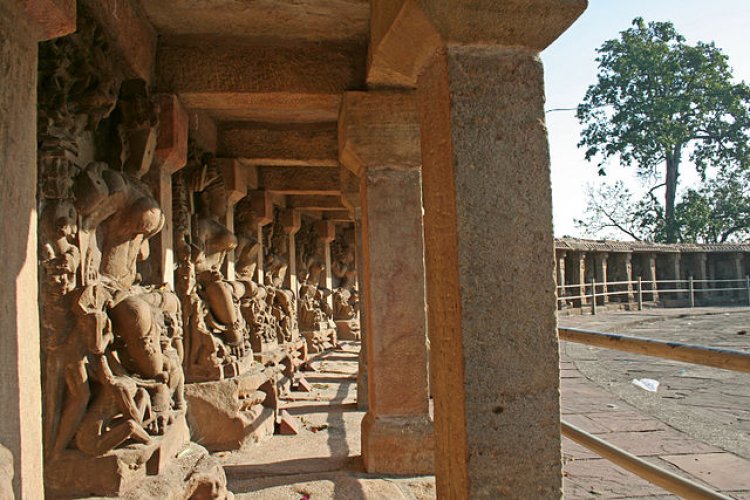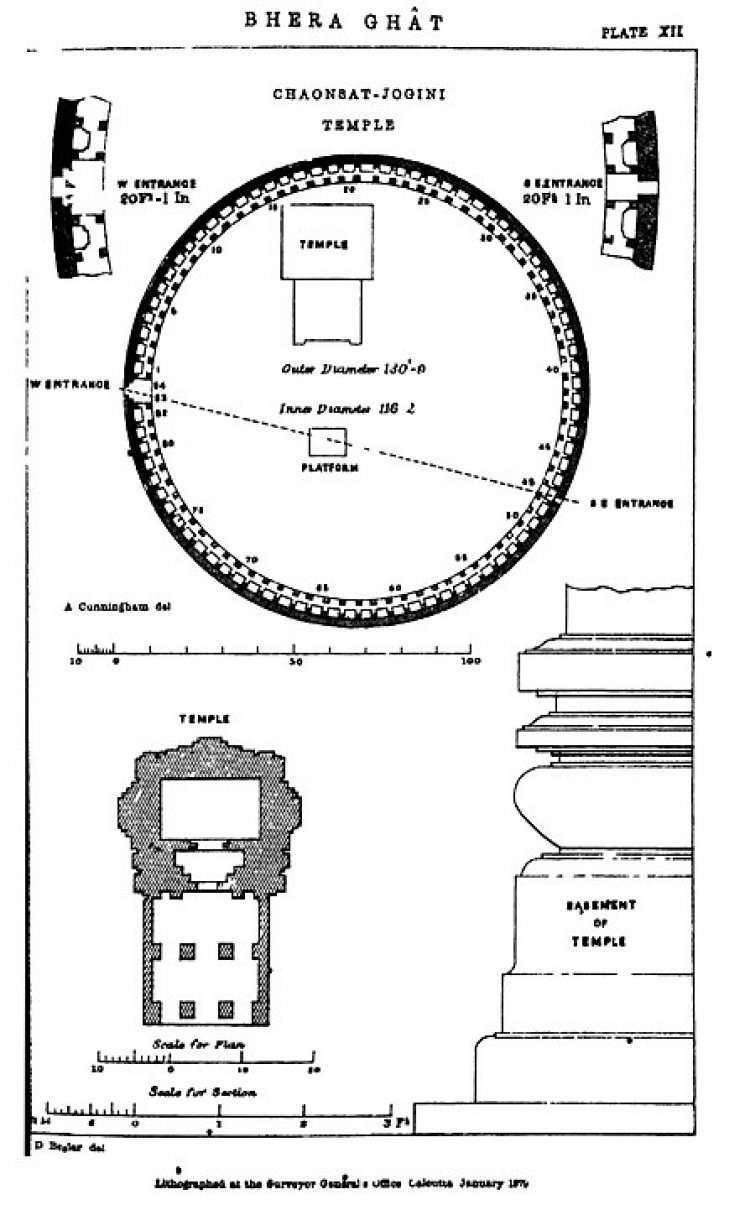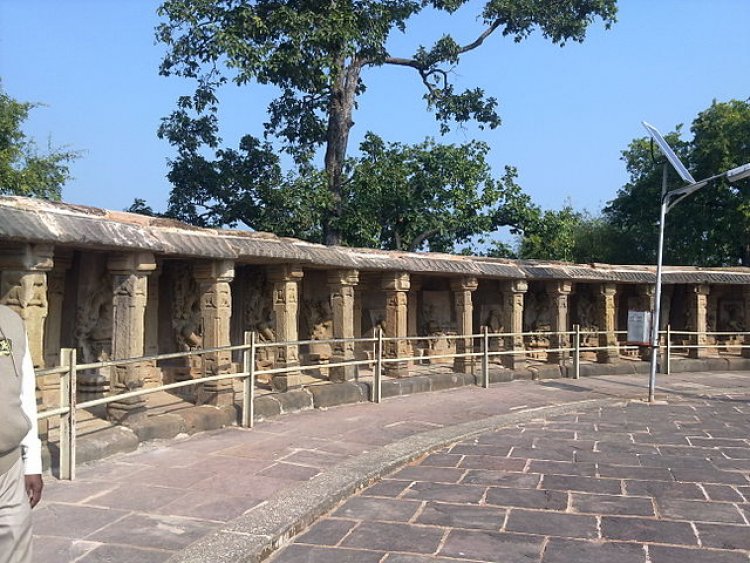Chausath Yogini Temple, Bhedaghat - Golaki Math
JabalPur MP,

The Chausath Yogini Temple, Bhedaghat, also called the Golaki Math ("circular lodge"), is one of India's Yogini temples, but exceptionally it has shrines for 81 rather than the usual 64 yoginis. All the same, scholars include it among the 64-yogini temples (चौंसठ chausath meaning 64 in Hindi). The group of 81 (ekashiti in Hindi) is a mark of royalty, implying that the temple was founded by a king. The large temple is on a hilltop above the river Narmada in Bhedaghat (Hindi भेड़ाघाट, also transliterated Bheraghat), some 5 km from Jabalpur, Madhya Pradesh.

The temple is the largest of the circular yogini temples, some 125 feet in diameter. The scholar Shaman Hatley calls it the "most imposing and perhaps best known of the yogini temples". It has a covered walkway with 81 cells for yoginis around the inside of its circular wall; three niches, two to the west, and one to the southeast, remain open as entrances.
There is a later shrine in the centre of the courtyard; the temple was adapted as a Gauri-Shankar temple with the construction of the building in the south-centre of the circle in 1155 AD, at which time the central deities (Bhairava or dancing Shiva) were moved.
The temple was built early in the 11th Century AD by King Yuvaraja II, of the dynasty of the Kalachuris of Tripuri; he lived around 975-1025 AD.
The city of Tripuri was four miles away, just across the Narmada river from the temple. According to the scholar David Gordon White, the temple would have been the Kalachuri dynasty's largest building project. The town's name was formerly Bhairavaghat; yogini temples held an image of either Shiva or Bhairava at their centre.

About the Yogini's
The temple contains stone images of the yoginis; among them are Kamada ("Giver of Sexual Love"), whose image includes a yoni puja, worship of the yoni. The 81 images include 8 Matrikas, Mother goddesses, from an earlier time; one of them is Chandika, who is depicted riding a human corpse in a cremation ground.
Three niches are now occupied by male gods, namely a dancing Ganesh and two Shiva, most likely from the central shrine as originally constructed. The yogini images that once occupied those niches have been lost, like many of the surviving but badly damaged yogini images heavily vandalised.
Most of the images have had their faces broken; some survive only from the waist down. One image, that of the horse-faced yogini Erudi, survives in perfect condition.
The scholar of Indian and South Asian art Vidya Dehejia writes that the yoginis form a "statuesque seated group", rather over life-size; she describes them as "mature, voluptuous beauties, generously endowed with ample hips and heavy melon-like breasts".
They are naked down to the waist, adorned with many earrings, necklaces, garlands, armlets, and bracelets. On their hips, they bear a "jewelled girdle" that supports a flimsy ankle-length skirt. Each has a halo and from 4 to 18 arms, both attributes of divinity; their faces are dignified and majestic, unsmiling.
The "regal presence" of the yoginis suggests to Dehejia that the yoginis are either acolytes or directly aspects of Devi, the Great Goddess. Both Kamada and Sarvatomukhi are names of Devi; the Sarvatomukhi image has three faces, with large teeth, bristling hair, a garland of skulls, and a terrifying aspect.
Each yogini image is carved from a rectangular slab of stone with several smaller figures on the base, an ornate throne, and flying deities above. The slab's base contains a label chiselled into the stone; each slab stands on a stone pedestal.
The smaller figures are mostly in scenes of cremation grounds, with what White calls "flesh-eating ghouls" along with scavenging jackals and birds. Human yoginis and their male counterparts, yogeshvaris, are depicted, but with few or no indications of sexual practices: there are some thin ithyphallic male figures.
Many of the human yoginis are shown eating severed human limbs. The 81 yoginis are described in the Mula Chakra of the Sri Matottara Tantra, which survives in manuscript form in Nepal. It tells of 9 Matrikas (not the usual 8); each is counted as a yogini and leads a group of 8 other yoginis so that there are 9 groups of 9.
The inscriptions identify six of the Matrikas as Varahi, Brahmani, Maheshvari, Indrani, and Vaishnavi, along with Chandika who is not usually included as a Matrika but is named in the Mula Chakra. Dehejia suggests that two of the heavily damaged images may be of Chamunda and Mahalakshmi and that an image of Kaumari found at another site, Mandla looks as if it was one of the Bheraghat yoginis.
Note: please Comment Here for UPDATES and CORRECTIONS
Donate. Buy Us Coffee
Why news media is in crisis & How you can fix it.
India needs free, fair, non-hyphenated and questioning journalism even more as it faces multiple crises. But the news media is in a crisis of its own. There have been brutal layoffs and pay cuts. The best of journalism is shrinking, yielding to the crude prime-time spectacle. My digital news .in has very few young reporters, columnists and editors working for it. Sustaining journalism of this quality needs smart and thinking people like you to pay for it. Whether you live in India or overseas, you can do it here
Donate. https://mydigitalnews.in/donate
NOTE: Please email us for updates and corrections, if you wish to publish articles like this you can send them to info@mydigitalnews.in or mydigitalnews.in@gmail.com or you can Directicle write Articles on our Site by registering https://mydigitalnews.in/register
Disclaimer: Mydigitalnews.in provides the content from various information sources ‘as is and the content to be used only for informational purposes and not responsible for the inaccuracy or deficiency of the provided information. Mydigitalnews. in have the right, at its sole discretion, to make modifications in any aspect of the provided information.
Mydigitalnews. in Internet site may contain links to other Internet sites. While we try to link only to sites that share our high standards and respect for privacy, we are not responsible for the content or the privacy practices employed by other sites.
What's Your Reaction?










































































